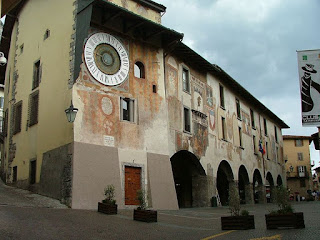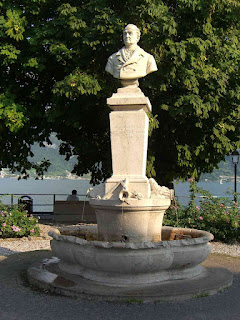Artist who lived in Rome but stayed in touch with ‘home’ city
 |
| Benzoni's self-portrait bust resides at the Biblioteca Civica Angelo Mai |
He became a member of the University of Bergamo and accepted commissions to create busts of famous citizens. His own self-portrait bust resides in the Biblioteca Civica Angelo Mai, on Piazza Vecchia in the Città Alta.
Benzoni became so famous in Rome in the first half of the 19th century that collectors and arts patrons in the city dubbed him the “new Canova” after the great Neoclassical sculptor Antonio Canova.
Born on 28 August, 1809 - 214 years ago today, Benzoni moved to Rome as a teenager to take a job in another sculptor’s workshop and to study his craft at the prestigious Accademia di San Luca, later setting up his own workshop in the capital, where he produced hundreds of allegorical and mythological scenes as well as busts and funerary monuments.
Yet he was regarded by Romans as a bergamasco - one of a celebrated group of bergamaschi based in Rome in the early 19th century, including the composer Gaetano Donizetti, the philologist Cardinal Angelo Mai and the painter Francesco Coghetti.
He was later commissioned to sculpt a monumental tomb for Cardinal Mai in the Basilica of Sant’Anastasia al Palatino in the centre of Rome.
 |
| The frescoed Torre dell'Orologio in the town of Clusone, hear Benzoni's home village |
His parents, Giuseppe and Margherita, were poor farmers. Giovanni Maria worked briefly as a shepherd, but his father died when he was around 11 years old, after which he was sent to work in his uncle’s small carpentry shop at Riva di Solto, on the western shore of Lago d’Iseo, around 40km (25 miles) from Bergamo.
He began to show a talent for carving religious statues which came to the attention of a wealthy patron called Giuseppe Fontana, who was impressed enough to speak about him to Count Luigi Tadini, who would later open the Tadini Academy of Fine Arts in Lovere, another town on Lago d’Iseo.
Tadini asked Benzoni to make a copy of the Stele Tadini, the sculpture made for him by Antonio Canova in memory of the count’s son Faustino, who had died at a young age.
He was so impressed by Benzoni’s attention to detail and the accuracy of the reproduction that he arranged for him to attend a college in Lovere.
 |
| Benzoni's bust of his patron, Count Luigi Tadini, by the lake in Lovere |
Benzoni’s elegant marble sculptures had echoes of Canova’s work and collectors in Rome soon began to speak of him as “il novello Canova” - the new Canova.
After earning some money for his work, he opened a small studio in Via Sant'Isidoro, in the centre of Rome, off the street now called Via Vittorio Veneto.
He later moved to bigger premises in Via del Babuino, between the Spanish Steps and Piazza del Popolo, where he employed more than 50 assistants. Among his most famous works were Cupid and Psyche, the Veiled Rebecca and Flight from Pompeii.
Benzoni, who married into a noble Roman family and had six children, sculpted a statue of his first patron, Count Luigi Tadini, which stands on a plinth in a lakeside garden opposite the Tadini Academy in Lovere.
Tadini established the Accademia di Belle Arti Tadini in the lakefront Palazzo Tadini in 1829 and it has become one of the most important art galleries in Italy.
Benzoni died in Rome in 1873.